University Essay: Analysis of BioHealth and De Waal Mergers
VerifiedAdded on 2023/06/04
|11
|2865
|399
Essay
AI Summary
This essay examines the strategic merger between BioHealth, an American pharmaceutical company, and De Waal, a Dutch-based pharmaceutical firm. The analysis focuses on the challenges arising from the merger, including communication breakdowns, conflicting values, and leadership issues. The essay highlights the concerns of employees, particularly regarding the lack of clear communication and the uncertainty surrounding their roles. It critiques the decision-making processes of key executives, Steve and Kaspar, emphasizing the importance of data-driven decisions and clear selection criteria for management. The essay recommends a more transparent and structured approach to executive selection, emphasizing the need for a balanced team and a clear framework. It also discusses how conflicting values between leaders should be resolved, and the importance of forging a healthy relationship and addressing cultural differences to achieve organizational goals. The essay concludes by critiquing the leadership styles of the executives involved and emphasizing the need for effective communication and decisive action to ensure the success of the merger. The assignment is contributed by a student to be published on the website Desklib. Desklib is a platform which provides all the necessary AI based study tools for students.

1
Mergers
Essay
Date
Student’s Name
University
Mergers
Essay
Date
Student’s Name
University
Paraphrase This Document
Need a fresh take? Get an instant paraphrase of this document with our AI Paraphraser
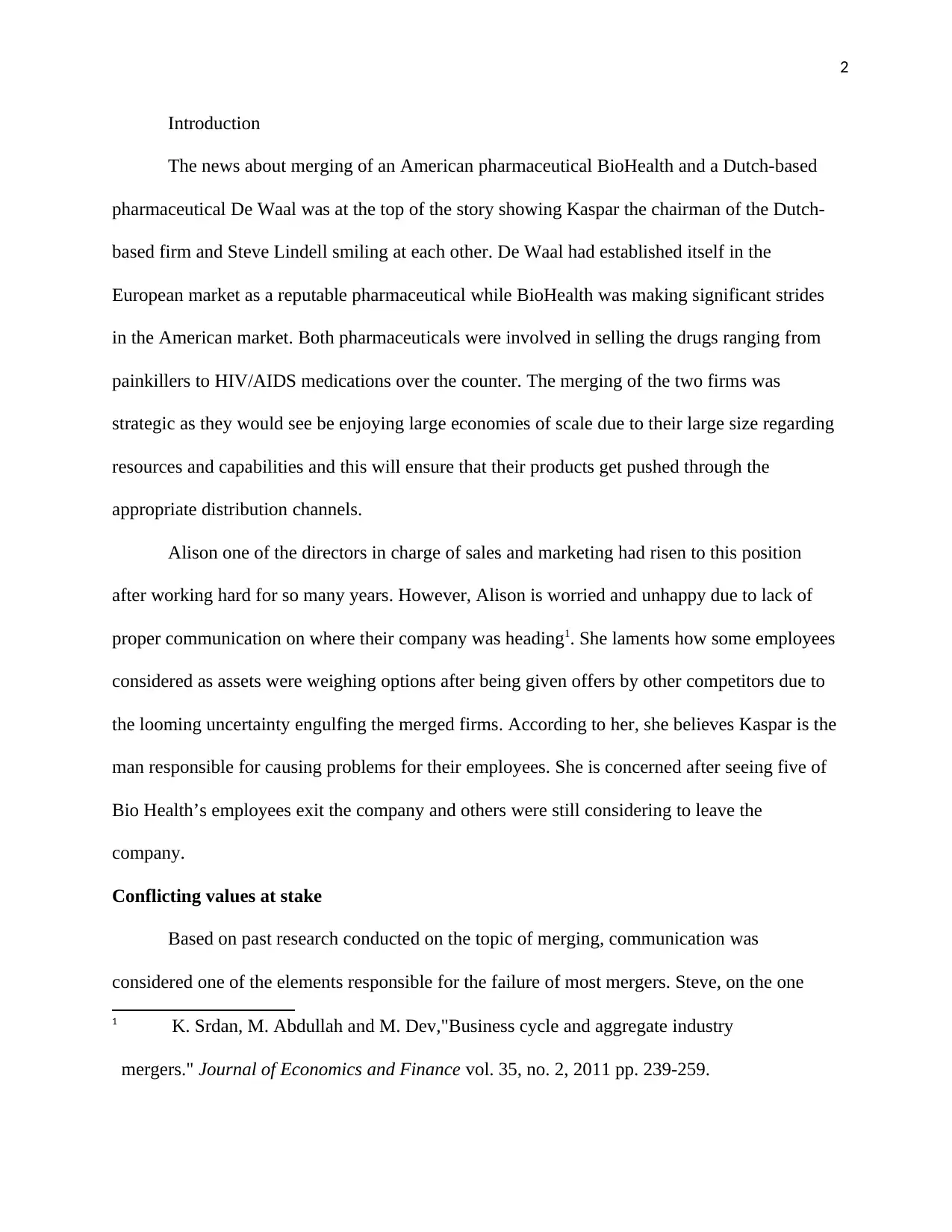
2
Introduction
The news about merging of an American pharmaceutical BioHealth and a Dutch-based
pharmaceutical De Waal was at the top of the story showing Kaspar the chairman of the Dutch-
based firm and Steve Lindell smiling at each other. De Waal had established itself in the
European market as a reputable pharmaceutical while BioHealth was making significant strides
in the American market. Both pharmaceuticals were involved in selling the drugs ranging from
painkillers to HIV/AIDS medications over the counter. The merging of the two firms was
strategic as they would see be enjoying large economies of scale due to their large size regarding
resources and capabilities and this will ensure that their products get pushed through the
appropriate distribution channels.
Alison one of the directors in charge of sales and marketing had risen to this position
after working hard for so many years. However, Alison is worried and unhappy due to lack of
proper communication on where their company was heading1. She laments how some employees
considered as assets were weighing options after being given offers by other competitors due to
the looming uncertainty engulfing the merged firms. According to her, she believes Kaspar is the
man responsible for causing problems for their employees. She is concerned after seeing five of
Bio Health’s employees exit the company and others were still considering to leave the
company.
Conflicting values at stake
Based on past research conducted on the topic of merging, communication was
considered one of the elements responsible for the failure of most mergers. Steve, on the one
1 K. Srdan, M. Abdullah and M. Dev,"Business cycle and aggregate industry
mergers." Journal of Economics and Finance vol. 35, no. 2, 2011 pp. 239-259.
Introduction
The news about merging of an American pharmaceutical BioHealth and a Dutch-based
pharmaceutical De Waal was at the top of the story showing Kaspar the chairman of the Dutch-
based firm and Steve Lindell smiling at each other. De Waal had established itself in the
European market as a reputable pharmaceutical while BioHealth was making significant strides
in the American market. Both pharmaceuticals were involved in selling the drugs ranging from
painkillers to HIV/AIDS medications over the counter. The merging of the two firms was
strategic as they would see be enjoying large economies of scale due to their large size regarding
resources and capabilities and this will ensure that their products get pushed through the
appropriate distribution channels.
Alison one of the directors in charge of sales and marketing had risen to this position
after working hard for so many years. However, Alison is worried and unhappy due to lack of
proper communication on where their company was heading1. She laments how some employees
considered as assets were weighing options after being given offers by other competitors due to
the looming uncertainty engulfing the merged firms. According to her, she believes Kaspar is the
man responsible for causing problems for their employees. She is concerned after seeing five of
Bio Health’s employees exit the company and others were still considering to leave the
company.
Conflicting values at stake
Based on past research conducted on the topic of merging, communication was
considered one of the elements responsible for the failure of most mergers. Steve, on the one
1 K. Srdan, M. Abdullah and M. Dev,"Business cycle and aggregate industry
mergers." Journal of Economics and Finance vol. 35, no. 2, 2011 pp. 239-259.
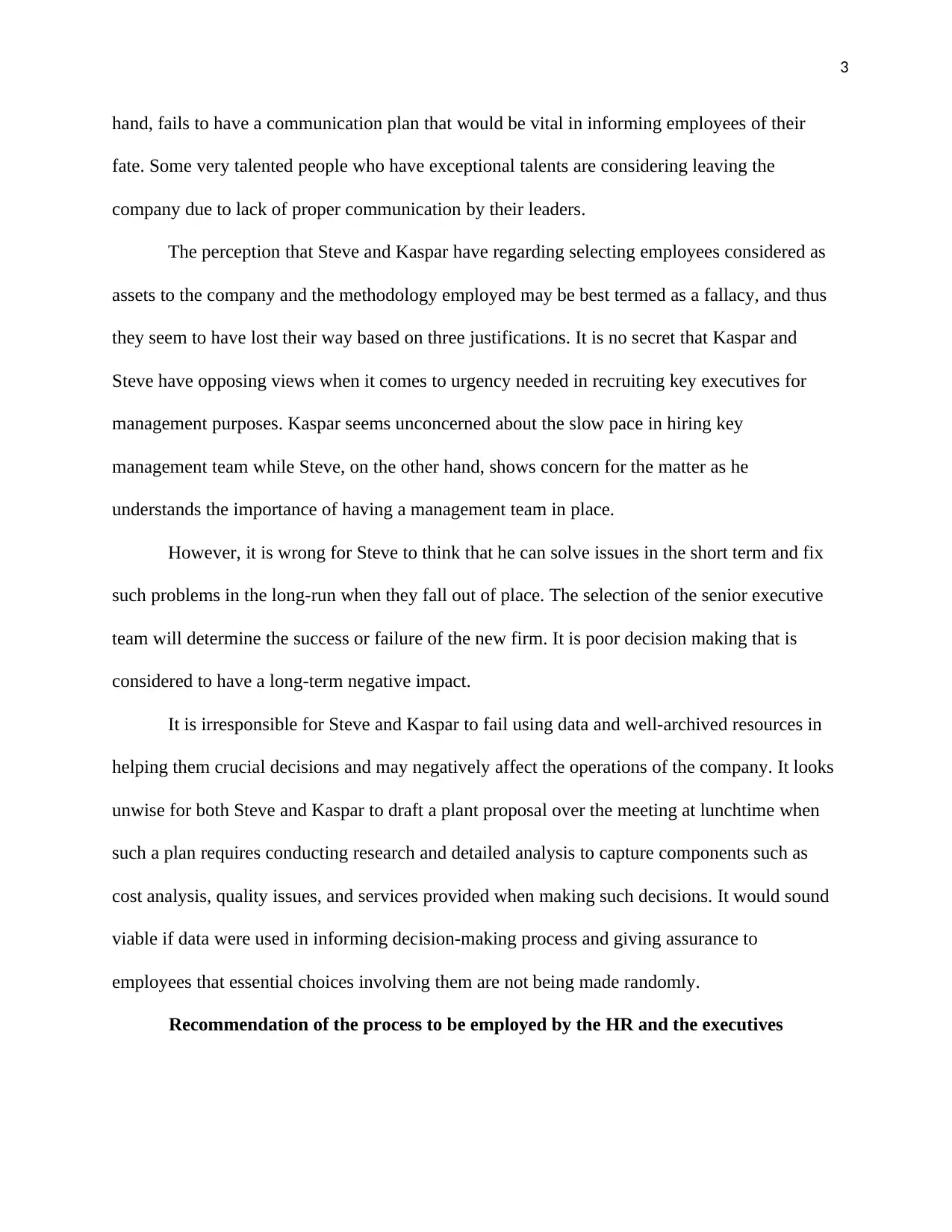
3
hand, fails to have a communication plan that would be vital in informing employees of their
fate. Some very talented people who have exceptional talents are considering leaving the
company due to lack of proper communication by their leaders.
The perception that Steve and Kaspar have regarding selecting employees considered as
assets to the company and the methodology employed may be best termed as a fallacy, and thus
they seem to have lost their way based on three justifications. It is no secret that Kaspar and
Steve have opposing views when it comes to urgency needed in recruiting key executives for
management purposes. Kaspar seems unconcerned about the slow pace in hiring key
management team while Steve, on the other hand, shows concern for the matter as he
understands the importance of having a management team in place.
However, it is wrong for Steve to think that he can solve issues in the short term and fix
such problems in the long-run when they fall out of place. The selection of the senior executive
team will determine the success or failure of the new firm. It is poor decision making that is
considered to have a long-term negative impact.
It is irresponsible for Steve and Kaspar to fail using data and well-archived resources in
helping them crucial decisions and may negatively affect the operations of the company. It looks
unwise for both Steve and Kaspar to draft a plant proposal over the meeting at lunchtime when
such a plan requires conducting research and detailed analysis to capture components such as
cost analysis, quality issues, and services provided when making such decisions. It would sound
viable if data were used in informing decision-making process and giving assurance to
employees that essential choices involving them are not being made randomly.
Recommendation of the process to be employed by the HR and the executives
hand, fails to have a communication plan that would be vital in informing employees of their
fate. Some very talented people who have exceptional talents are considering leaving the
company due to lack of proper communication by their leaders.
The perception that Steve and Kaspar have regarding selecting employees considered as
assets to the company and the methodology employed may be best termed as a fallacy, and thus
they seem to have lost their way based on three justifications. It is no secret that Kaspar and
Steve have opposing views when it comes to urgency needed in recruiting key executives for
management purposes. Kaspar seems unconcerned about the slow pace in hiring key
management team while Steve, on the other hand, shows concern for the matter as he
understands the importance of having a management team in place.
However, it is wrong for Steve to think that he can solve issues in the short term and fix
such problems in the long-run when they fall out of place. The selection of the senior executive
team will determine the success or failure of the new firm. It is poor decision making that is
considered to have a long-term negative impact.
It is irresponsible for Steve and Kaspar to fail using data and well-archived resources in
helping them crucial decisions and may negatively affect the operations of the company. It looks
unwise for both Steve and Kaspar to draft a plant proposal over the meeting at lunchtime when
such a plan requires conducting research and detailed analysis to capture components such as
cost analysis, quality issues, and services provided when making such decisions. It would sound
viable if data were used in informing decision-making process and giving assurance to
employees that essential choices involving them are not being made randomly.
Recommendation of the process to be employed by the HR and the executives
⊘ This is a preview!⊘
Do you want full access?
Subscribe today to unlock all pages.

Trusted by 1+ million students worldwide
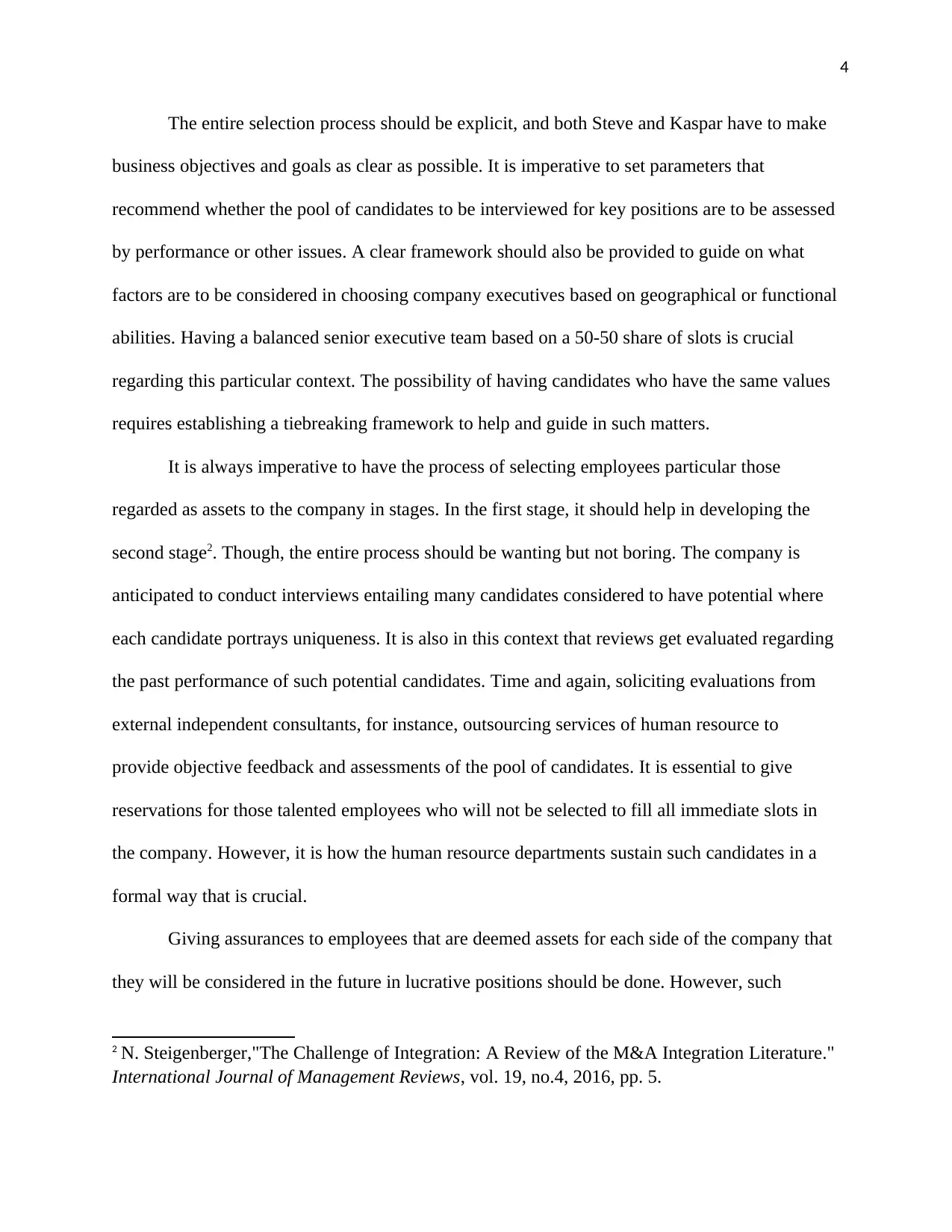
4
The entire selection process should be explicit, and both Steve and Kaspar have to make
business objectives and goals as clear as possible. It is imperative to set parameters that
recommend whether the pool of candidates to be interviewed for key positions are to be assessed
by performance or other issues. A clear framework should also be provided to guide on what
factors are to be considered in choosing company executives based on geographical or functional
abilities. Having a balanced senior executive team based on a 50-50 share of slots is crucial
regarding this particular context. The possibility of having candidates who have the same values
requires establishing a tiebreaking framework to help and guide in such matters.
It is always imperative to have the process of selecting employees particular those
regarded as assets to the company in stages. In the first stage, it should help in developing the
second stage2. Though, the entire process should be wanting but not boring. The company is
anticipated to conduct interviews entailing many candidates considered to have potential where
each candidate portrays uniqueness. It is also in this context that reviews get evaluated regarding
the past performance of such potential candidates. Time and again, soliciting evaluations from
external independent consultants, for instance, outsourcing services of human resource to
provide objective feedback and assessments of the pool of candidates. It is essential to give
reservations for those talented employees who will not be selected to fill all immediate slots in
the company. However, it is how the human resource departments sustain such candidates in a
formal way that is crucial.
Giving assurances to employees that are deemed assets for each side of the company that
they will be considered in the future in lucrative positions should be done. However, such
2 N. Steigenberger,"The Challenge of Integration: A Review of the M&A Integration Literature."
International Journal of Management Reviews, vol. 19, no.4, 2016, pp. 5.
The entire selection process should be explicit, and both Steve and Kaspar have to make
business objectives and goals as clear as possible. It is imperative to set parameters that
recommend whether the pool of candidates to be interviewed for key positions are to be assessed
by performance or other issues. A clear framework should also be provided to guide on what
factors are to be considered in choosing company executives based on geographical or functional
abilities. Having a balanced senior executive team based on a 50-50 share of slots is crucial
regarding this particular context. The possibility of having candidates who have the same values
requires establishing a tiebreaking framework to help and guide in such matters.
It is always imperative to have the process of selecting employees particular those
regarded as assets to the company in stages. In the first stage, it should help in developing the
second stage2. Though, the entire process should be wanting but not boring. The company is
anticipated to conduct interviews entailing many candidates considered to have potential where
each candidate portrays uniqueness. It is also in this context that reviews get evaluated regarding
the past performance of such potential candidates. Time and again, soliciting evaluations from
external independent consultants, for instance, outsourcing services of human resource to
provide objective feedback and assessments of the pool of candidates. It is essential to give
reservations for those talented employees who will not be selected to fill all immediate slots in
the company. However, it is how the human resource departments sustain such candidates in a
formal way that is crucial.
Giving assurances to employees that are deemed assets for each side of the company that
they will be considered in the future in lucrative positions should be done. However, such
2 N. Steigenberger,"The Challenge of Integration: A Review of the M&A Integration Literature."
International Journal of Management Reviews, vol. 19, no.4, 2016, pp. 5.
Paraphrase This Document
Need a fresh take? Get an instant paraphrase of this document with our AI Paraphraser
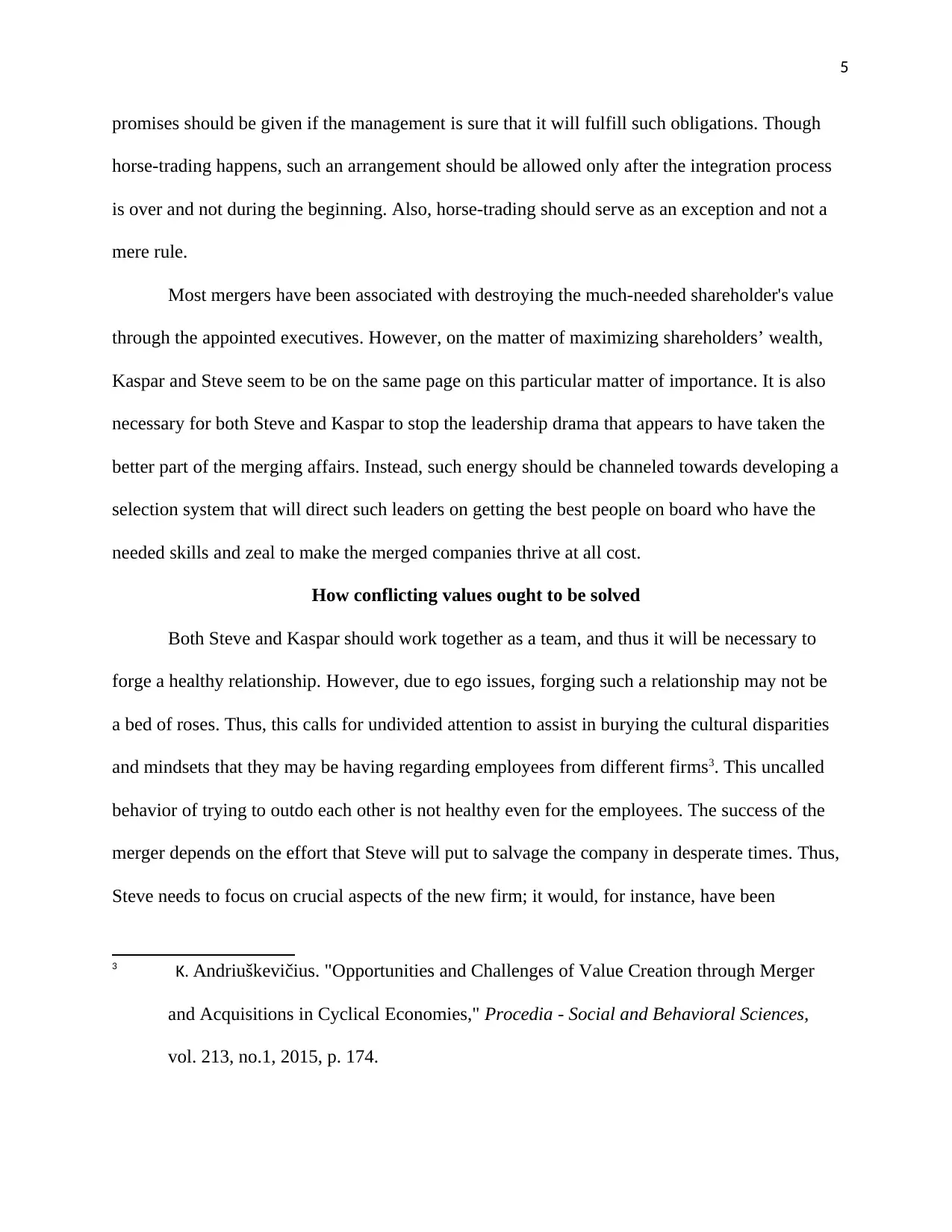
5
promises should be given if the management is sure that it will fulfill such obligations. Though
horse-trading happens, such an arrangement should be allowed only after the integration process
is over and not during the beginning. Also, horse-trading should serve as an exception and not a
mere rule.
Most mergers have been associated with destroying the much-needed shareholder's value
through the appointed executives. However, on the matter of maximizing shareholders’ wealth,
Kaspar and Steve seem to be on the same page on this particular matter of importance. It is also
necessary for both Steve and Kaspar to stop the leadership drama that appears to have taken the
better part of the merging affairs. Instead, such energy should be channeled towards developing a
selection system that will direct such leaders on getting the best people on board who have the
needed skills and zeal to make the merged companies thrive at all cost.
How conflicting values ought to be solved
Both Steve and Kaspar should work together as a team, and thus it will be necessary to
forge a healthy relationship. However, due to ego issues, forging such a relationship may not be
a bed of roses. Thus, this calls for undivided attention to assist in burying the cultural disparities
and mindsets that they may be having regarding employees from different firms3. This uncalled
behavior of trying to outdo each other is not healthy even for the employees. The success of the
merger depends on the effort that Steve will put to salvage the company in desperate times. Thus,
Steve needs to focus on crucial aspects of the new firm; it would, for instance, have been
3 K. Andriuškevičius. "Opportunities and Challenges of Value Creation through Merger
and Acquisitions in Cyclical Economies," Procedia - Social and Behavioral Sciences,
vol. 213, no.1, 2015, p. 174.
promises should be given if the management is sure that it will fulfill such obligations. Though
horse-trading happens, such an arrangement should be allowed only after the integration process
is over and not during the beginning. Also, horse-trading should serve as an exception and not a
mere rule.
Most mergers have been associated with destroying the much-needed shareholder's value
through the appointed executives. However, on the matter of maximizing shareholders’ wealth,
Kaspar and Steve seem to be on the same page on this particular matter of importance. It is also
necessary for both Steve and Kaspar to stop the leadership drama that appears to have taken the
better part of the merging affairs. Instead, such energy should be channeled towards developing a
selection system that will direct such leaders on getting the best people on board who have the
needed skills and zeal to make the merged companies thrive at all cost.
How conflicting values ought to be solved
Both Steve and Kaspar should work together as a team, and thus it will be necessary to
forge a healthy relationship. However, due to ego issues, forging such a relationship may not be
a bed of roses. Thus, this calls for undivided attention to assist in burying the cultural disparities
and mindsets that they may be having regarding employees from different firms3. This uncalled
behavior of trying to outdo each other is not healthy even for the employees. The success of the
merger depends on the effort that Steve will put to salvage the company in desperate times. Thus,
Steve needs to focus on crucial aspects of the new firm; it would, for instance, have been
3 K. Andriuškevičius. "Opportunities and Challenges of Value Creation through Merger
and Acquisitions in Cyclical Economies," Procedia - Social and Behavioral Sciences,
vol. 213, no.1, 2015, p. 174.
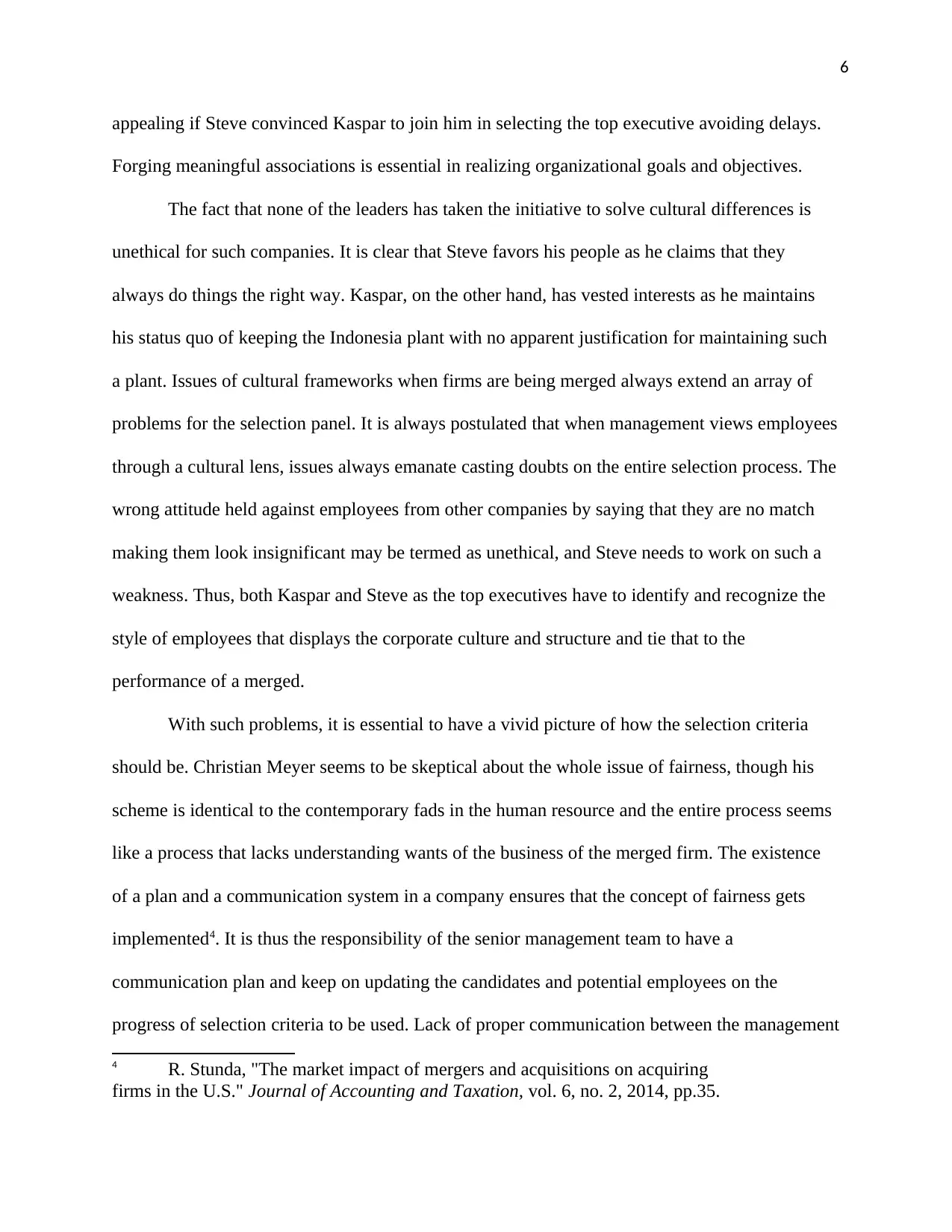
6
appealing if Steve convinced Kaspar to join him in selecting the top executive avoiding delays.
Forging meaningful associations is essential in realizing organizational goals and objectives.
The fact that none of the leaders has taken the initiative to solve cultural differences is
unethical for such companies. It is clear that Steve favors his people as he claims that they
always do things the right way. Kaspar, on the other hand, has vested interests as he maintains
his status quo of keeping the Indonesia plant with no apparent justification for maintaining such
a plant. Issues of cultural frameworks when firms are being merged always extend an array of
problems for the selection panel. It is always postulated that when management views employees
through a cultural lens, issues always emanate casting doubts on the entire selection process. The
wrong attitude held against employees from other companies by saying that they are no match
making them look insignificant may be termed as unethical, and Steve needs to work on such a
weakness. Thus, both Kaspar and Steve as the top executives have to identify and recognize the
style of employees that displays the corporate culture and structure and tie that to the
performance of a merged.
With such problems, it is essential to have a vivid picture of how the selection criteria
should be. Christian Meyer seems to be skeptical about the whole issue of fairness, though his
scheme is identical to the contemporary fads in the human resource and the entire process seems
like a process that lacks understanding wants of the business of the merged firm. The existence
of a plan and a communication system in a company ensures that the concept of fairness gets
implemented4. It is thus the responsibility of the senior management team to have a
communication plan and keep on updating the candidates and potential employees on the
progress of selection criteria to be used. Lack of proper communication between the management
4 R. Stunda, "The market impact of mergers and acquisitions on acquiring
firms in the U.S." Journal of Accounting and Taxation, vol. 6, no. 2, 2014, pp.35.
appealing if Steve convinced Kaspar to join him in selecting the top executive avoiding delays.
Forging meaningful associations is essential in realizing organizational goals and objectives.
The fact that none of the leaders has taken the initiative to solve cultural differences is
unethical for such companies. It is clear that Steve favors his people as he claims that they
always do things the right way. Kaspar, on the other hand, has vested interests as he maintains
his status quo of keeping the Indonesia plant with no apparent justification for maintaining such
a plant. Issues of cultural frameworks when firms are being merged always extend an array of
problems for the selection panel. It is always postulated that when management views employees
through a cultural lens, issues always emanate casting doubts on the entire selection process. The
wrong attitude held against employees from other companies by saying that they are no match
making them look insignificant may be termed as unethical, and Steve needs to work on such a
weakness. Thus, both Kaspar and Steve as the top executives have to identify and recognize the
style of employees that displays the corporate culture and structure and tie that to the
performance of a merged.
With such problems, it is essential to have a vivid picture of how the selection criteria
should be. Christian Meyer seems to be skeptical about the whole issue of fairness, though his
scheme is identical to the contemporary fads in the human resource and the entire process seems
like a process that lacks understanding wants of the business of the merged firm. The existence
of a plan and a communication system in a company ensures that the concept of fairness gets
implemented4. It is thus the responsibility of the senior management team to have a
communication plan and keep on updating the candidates and potential employees on the
progress of selection criteria to be used. Lack of proper communication between the management
4 R. Stunda, "The market impact of mergers and acquisitions on acquiring
firms in the U.S." Journal of Accounting and Taxation, vol. 6, no. 2, 2014, pp.35.
⊘ This is a preview!⊘
Do you want full access?
Subscribe today to unlock all pages.

Trusted by 1+ million students worldwide
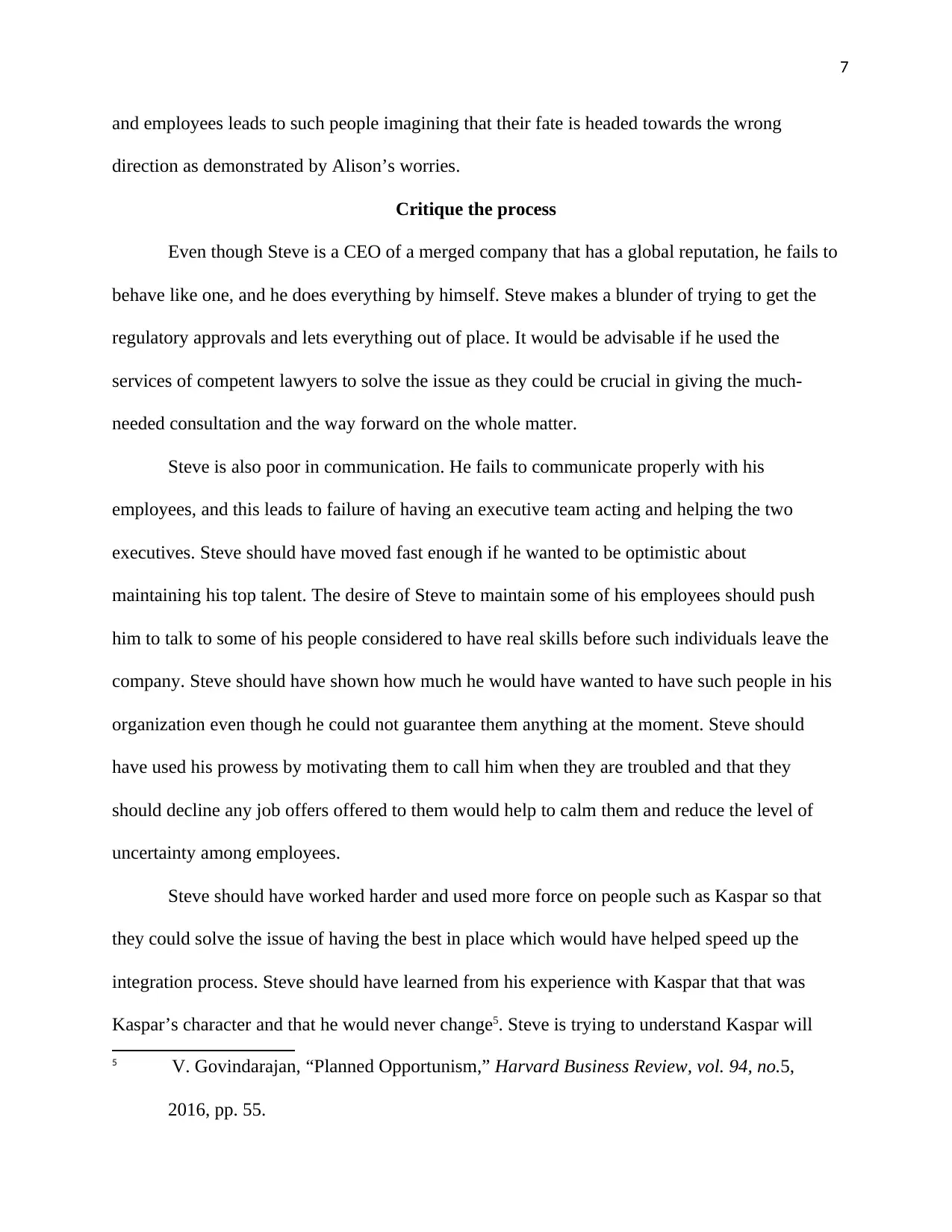
7
and employees leads to such people imagining that their fate is headed towards the wrong
direction as demonstrated by Alison’s worries.
Critique the process
Even though Steve is a CEO of a merged company that has a global reputation, he fails to
behave like one, and he does everything by himself. Steve makes a blunder of trying to get the
regulatory approvals and lets everything out of place. It would be advisable if he used the
services of competent lawyers to solve the issue as they could be crucial in giving the much-
needed consultation and the way forward on the whole matter.
Steve is also poor in communication. He fails to communicate properly with his
employees, and this leads to failure of having an executive team acting and helping the two
executives. Steve should have moved fast enough if he wanted to be optimistic about
maintaining his top talent. The desire of Steve to maintain some of his employees should push
him to talk to some of his people considered to have real skills before such individuals leave the
company. Steve should have shown how much he would have wanted to have such people in his
organization even though he could not guarantee them anything at the moment. Steve should
have used his prowess by motivating them to call him when they are troubled and that they
should decline any job offers offered to them would help to calm them and reduce the level of
uncertainty among employees.
Steve should have worked harder and used more force on people such as Kaspar so that
they could solve the issue of having the best in place which would have helped speed up the
integration process. Steve should have learned from his experience with Kaspar that that was
Kaspar’s character and that he would never change5. Steve is trying to understand Kaspar will
5 V. Govindarajan, “Planned Opportunism,” Harvard Business Review, vol. 94, no.5,
2016, pp. 55.
and employees leads to such people imagining that their fate is headed towards the wrong
direction as demonstrated by Alison’s worries.
Critique the process
Even though Steve is a CEO of a merged company that has a global reputation, he fails to
behave like one, and he does everything by himself. Steve makes a blunder of trying to get the
regulatory approvals and lets everything out of place. It would be advisable if he used the
services of competent lawyers to solve the issue as they could be crucial in giving the much-
needed consultation and the way forward on the whole matter.
Steve is also poor in communication. He fails to communicate properly with his
employees, and this leads to failure of having an executive team acting and helping the two
executives. Steve should have moved fast enough if he wanted to be optimistic about
maintaining his top talent. The desire of Steve to maintain some of his employees should push
him to talk to some of his people considered to have real skills before such individuals leave the
company. Steve should have shown how much he would have wanted to have such people in his
organization even though he could not guarantee them anything at the moment. Steve should
have used his prowess by motivating them to call him when they are troubled and that they
should decline any job offers offered to them would help to calm them and reduce the level of
uncertainty among employees.
Steve should have worked harder and used more force on people such as Kaspar so that
they could solve the issue of having the best in place which would have helped speed up the
integration process. Steve should have learned from his experience with Kaspar that that was
Kaspar’s character and that he would never change5. Steve is trying to understand Kaspar will
5 V. Govindarajan, “Planned Opportunism,” Harvard Business Review, vol. 94, no.5,
2016, pp. 55.
Paraphrase This Document
Need a fresh take? Get an instant paraphrase of this document with our AI Paraphraser
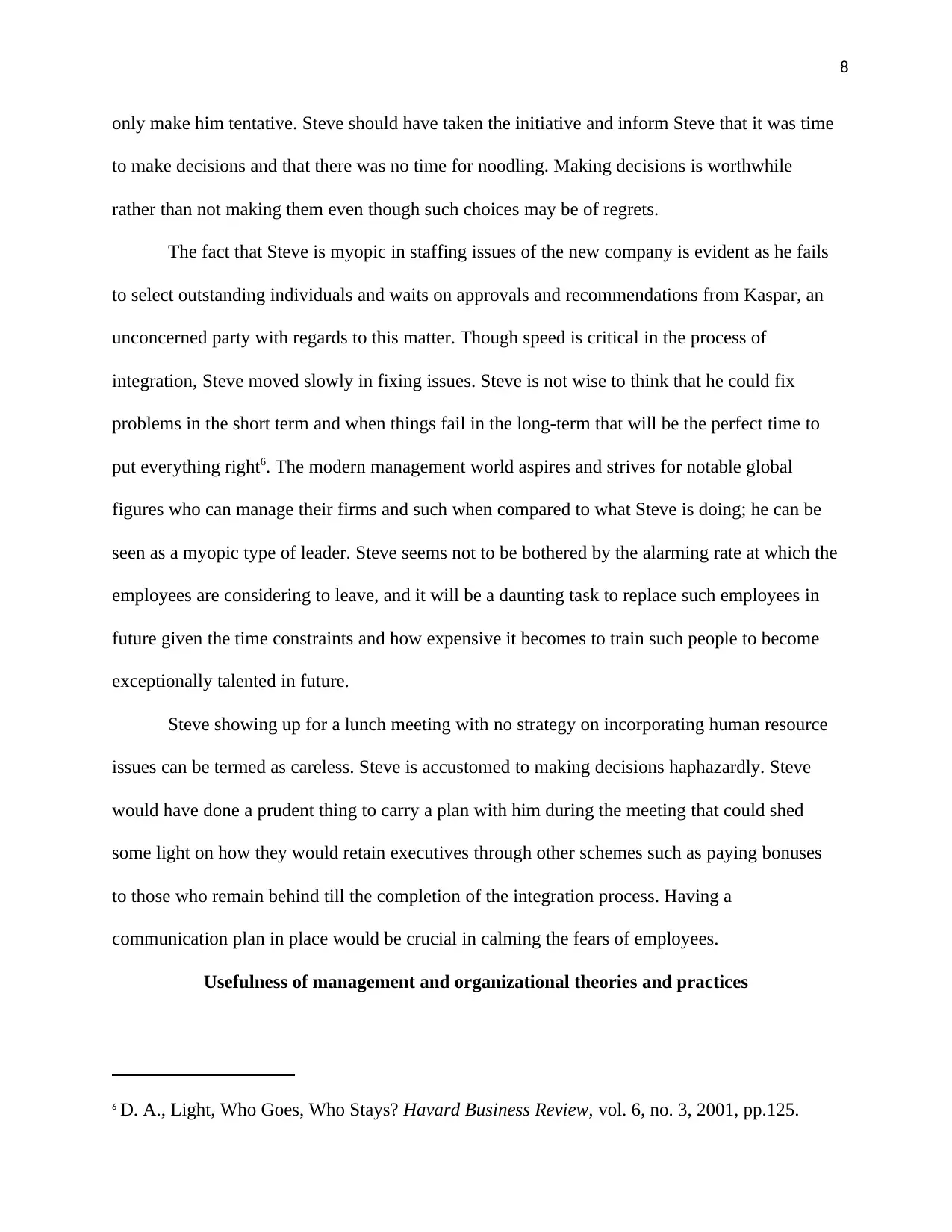
8
only make him tentative. Steve should have taken the initiative and inform Steve that it was time
to make decisions and that there was no time for noodling. Making decisions is worthwhile
rather than not making them even though such choices may be of regrets.
The fact that Steve is myopic in staffing issues of the new company is evident as he fails
to select outstanding individuals and waits on approvals and recommendations from Kaspar, an
unconcerned party with regards to this matter. Though speed is critical in the process of
integration, Steve moved slowly in fixing issues. Steve is not wise to think that he could fix
problems in the short term and when things fail in the long-term that will be the perfect time to
put everything right6. The modern management world aspires and strives for notable global
figures who can manage their firms and such when compared to what Steve is doing; he can be
seen as a myopic type of leader. Steve seems not to be bothered by the alarming rate at which the
employees are considering to leave, and it will be a daunting task to replace such employees in
future given the time constraints and how expensive it becomes to train such people to become
exceptionally talented in future.
Steve showing up for a lunch meeting with no strategy on incorporating human resource
issues can be termed as careless. Steve is accustomed to making decisions haphazardly. Steve
would have done a prudent thing to carry a plan with him during the meeting that could shed
some light on how they would retain executives through other schemes such as paying bonuses
to those who remain behind till the completion of the integration process. Having a
communication plan in place would be crucial in calming the fears of employees.
Usefulness of management and organizational theories and practices
6 D. A., Light, Who Goes, Who Stays? Havard Business Review, vol. 6, no. 3, 2001, pp.125.
only make him tentative. Steve should have taken the initiative and inform Steve that it was time
to make decisions and that there was no time for noodling. Making decisions is worthwhile
rather than not making them even though such choices may be of regrets.
The fact that Steve is myopic in staffing issues of the new company is evident as he fails
to select outstanding individuals and waits on approvals and recommendations from Kaspar, an
unconcerned party with regards to this matter. Though speed is critical in the process of
integration, Steve moved slowly in fixing issues. Steve is not wise to think that he could fix
problems in the short term and when things fail in the long-term that will be the perfect time to
put everything right6. The modern management world aspires and strives for notable global
figures who can manage their firms and such when compared to what Steve is doing; he can be
seen as a myopic type of leader. Steve seems not to be bothered by the alarming rate at which the
employees are considering to leave, and it will be a daunting task to replace such employees in
future given the time constraints and how expensive it becomes to train such people to become
exceptionally talented in future.
Steve showing up for a lunch meeting with no strategy on incorporating human resource
issues can be termed as careless. Steve is accustomed to making decisions haphazardly. Steve
would have done a prudent thing to carry a plan with him during the meeting that could shed
some light on how they would retain executives through other schemes such as paying bonuses
to those who remain behind till the completion of the integration process. Having a
communication plan in place would be crucial in calming the fears of employees.
Usefulness of management and organizational theories and practices
6 D. A., Light, Who Goes, Who Stays? Havard Business Review, vol. 6, no. 3, 2001, pp.125.
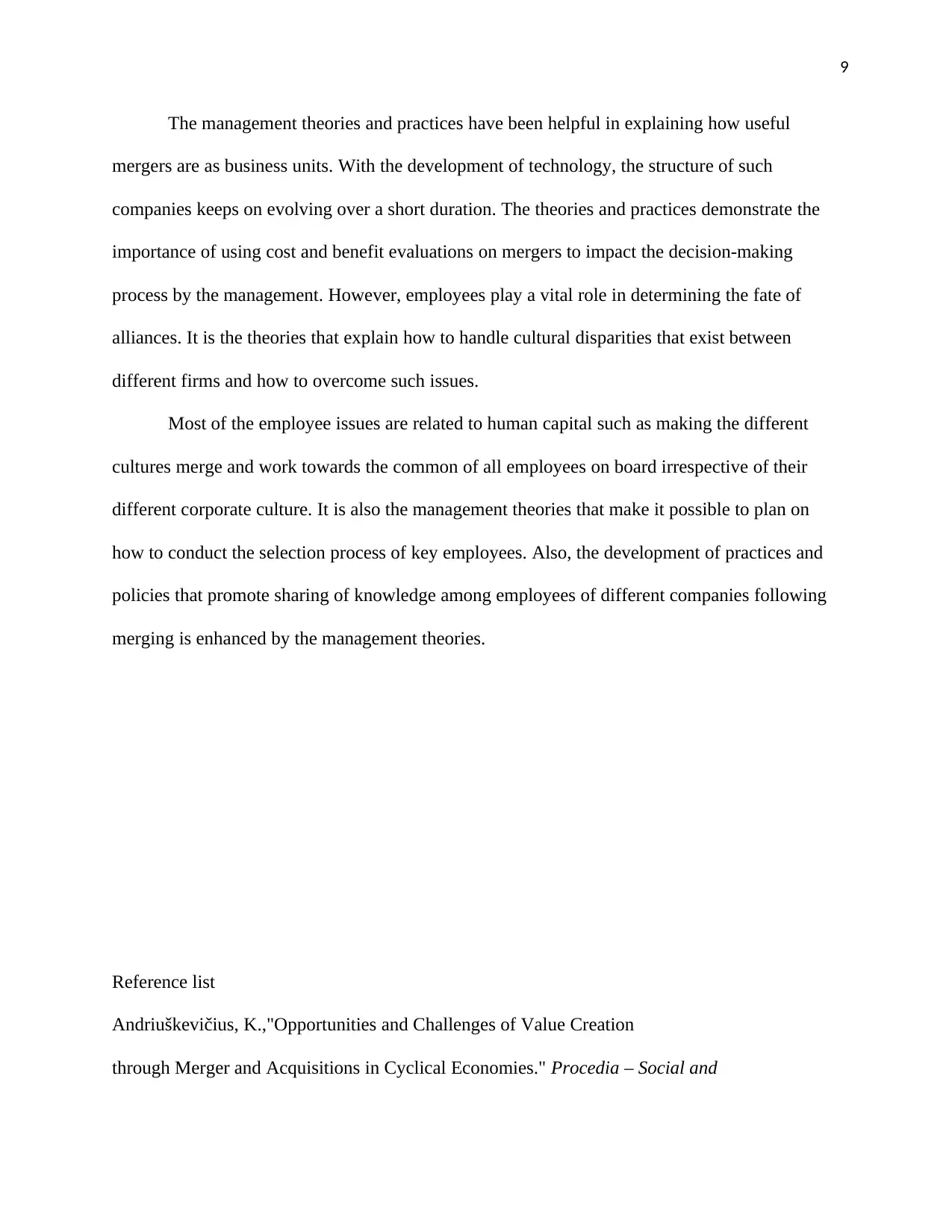
9
The management theories and practices have been helpful in explaining how useful
mergers are as business units. With the development of technology, the structure of such
companies keeps on evolving over a short duration. The theories and practices demonstrate the
importance of using cost and benefit evaluations on mergers to impact the decision-making
process by the management. However, employees play a vital role in determining the fate of
alliances. It is the theories that explain how to handle cultural disparities that exist between
different firms and how to overcome such issues.
Most of the employee issues are related to human capital such as making the different
cultures merge and work towards the common of all employees on board irrespective of their
different corporate culture. It is also the management theories that make it possible to plan on
how to conduct the selection process of key employees. Also, the development of practices and
policies that promote sharing of knowledge among employees of different companies following
merging is enhanced by the management theories.
Reference list
Andriuškevičius, K.,"Opportunities and Challenges of Value Creation
through Merger and Acquisitions in Cyclical Economies." Procedia – Social and
The management theories and practices have been helpful in explaining how useful
mergers are as business units. With the development of technology, the structure of such
companies keeps on evolving over a short duration. The theories and practices demonstrate the
importance of using cost and benefit evaluations on mergers to impact the decision-making
process by the management. However, employees play a vital role in determining the fate of
alliances. It is the theories that explain how to handle cultural disparities that exist between
different firms and how to overcome such issues.
Most of the employee issues are related to human capital such as making the different
cultures merge and work towards the common of all employees on board irrespective of their
different corporate culture. It is also the management theories that make it possible to plan on
how to conduct the selection process of key employees. Also, the development of practices and
policies that promote sharing of knowledge among employees of different companies following
merging is enhanced by the management theories.
Reference list
Andriuškevičius, K.,"Opportunities and Challenges of Value Creation
through Merger and Acquisitions in Cyclical Economies." Procedia – Social and
⊘ This is a preview!⊘
Do you want full access?
Subscribe today to unlock all pages.

Trusted by 1+ million students worldwide
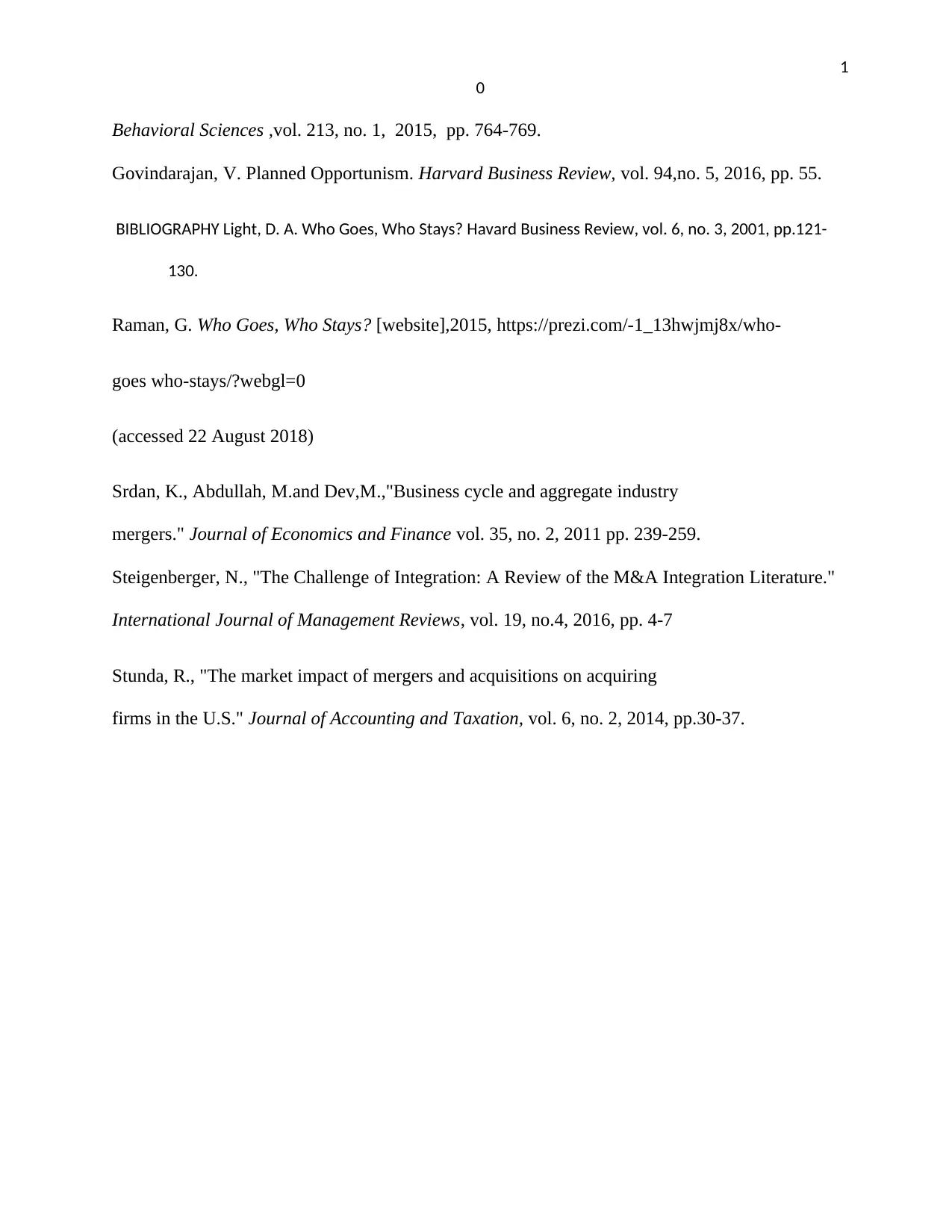
1
0
Behavioral Sciences ,vol. 213, no. 1, 2015, pp. 764-769.
Govindarajan, V. Planned Opportunism. Harvard Business Review, vol. 94,no. 5, 2016, pp. 55.
BIBLIOGRAPHY Light, D. A. Who Goes, Who Stays? Havard Business Review, vol. 6, no. 3, 2001, pp.121-
130.
Raman, G. Who Goes, Who Stays? [website],2015, https://prezi.com/-1_13hwjmj8x/who-
goes who-stays/?webgl=0
(accessed 22 August 2018)
Srdan, K., Abdullah, M.and Dev,M.,"Business cycle and aggregate industry
mergers." Journal of Economics and Finance vol. 35, no. 2, 2011 pp. 239-259.
Steigenberger, N., "The Challenge of Integration: A Review of the M&A Integration Literature."
International Journal of Management Reviews, vol. 19, no.4, 2016, pp. 4-7
Stunda, R., "The market impact of mergers and acquisitions on acquiring
firms in the U.S." Journal of Accounting and Taxation, vol. 6, no. 2, 2014, pp.30-37.
0
Behavioral Sciences ,vol. 213, no. 1, 2015, pp. 764-769.
Govindarajan, V. Planned Opportunism. Harvard Business Review, vol. 94,no. 5, 2016, pp. 55.
BIBLIOGRAPHY Light, D. A. Who Goes, Who Stays? Havard Business Review, vol. 6, no. 3, 2001, pp.121-
130.
Raman, G. Who Goes, Who Stays? [website],2015, https://prezi.com/-1_13hwjmj8x/who-
goes who-stays/?webgl=0
(accessed 22 August 2018)
Srdan, K., Abdullah, M.and Dev,M.,"Business cycle and aggregate industry
mergers." Journal of Economics and Finance vol. 35, no. 2, 2011 pp. 239-259.
Steigenberger, N., "The Challenge of Integration: A Review of the M&A Integration Literature."
International Journal of Management Reviews, vol. 19, no.4, 2016, pp. 4-7
Stunda, R., "The market impact of mergers and acquisitions on acquiring
firms in the U.S." Journal of Accounting and Taxation, vol. 6, no. 2, 2014, pp.30-37.
Paraphrase This Document
Need a fresh take? Get an instant paraphrase of this document with our AI Paraphraser

1
1
1
1 out of 11
Related Documents
Your All-in-One AI-Powered Toolkit for Academic Success.
+13062052269
info@desklib.com
Available 24*7 on WhatsApp / Email
![[object Object]](/_next/static/media/star-bottom.7253800d.svg)
Unlock your academic potential
Copyright © 2020–2025 A2Z Services. All Rights Reserved. Developed and managed by ZUCOL.




